Submitted by Megha Balooni
"We’ve moved people with a new sense of place and space in a way that goes beyond materiality"
Indonesia Architecture News - Nov 28, 2022 - 16:36 2994 views
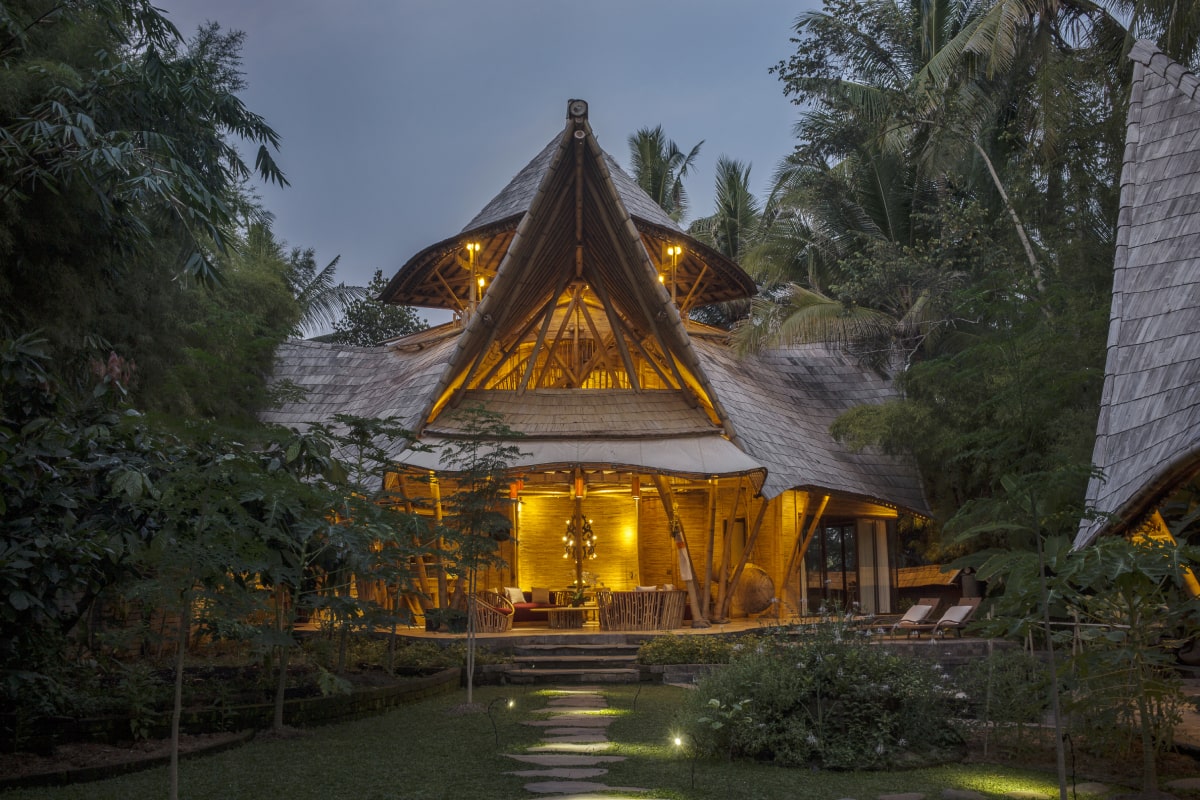
In continuation to our series, Significance of Materiality in Architecture, this series of interviews seeks to push the conversations surrounding materiality and its influence to shape the vision and final design of projects, regardless of its scale and scope. The series began with German architect Anna Heringer and was followed by Indian architects Sandeep Bogadhi and Raja Krishnan and Santhosh Shanmugam of Shanmugam Associates. Further in our series, I sat down with the team at IBUKU, led by Elora Hardy, to discuss their groundbreaking designs using bamboo as their primary building material.
Megha Balooni: Thank you for doing this interview with us. “People need nature, or rather to feel and remember that they are part of it.” – Even though sustainability has caught the attention and fancy of designers and architects the world over, what do you feel are some common mistakes or overlooked parameters encountered when designing on-ground?
Elora Hardy: While designers and artists idealize the goal of being innovative and creating something truly new, the direction of sustainability in recent decades has often been towards constraint or toward a trend usually involving recycling, which also shines a light on the past and the problem that on the future as we wish it to be. We can’t think outside the box while being in or focusing on the box itself. And even when there is a true intention to innovate, and even when there is truly an opportunity to innovate, there are many people and practicalities involved in every project, so it’s rare to actually align everyone involved to agree to head into the unknown together, off the well-paved path. For the future, we are looking towards things that hold the greatest promise of being bountiful, not simply sustainable. Abundant and regenerative, circular. Instead of striving to be a little bit less bad, are there ways we can work that are, while perhaps not yet perfect, the beginning of something that is inherently good?
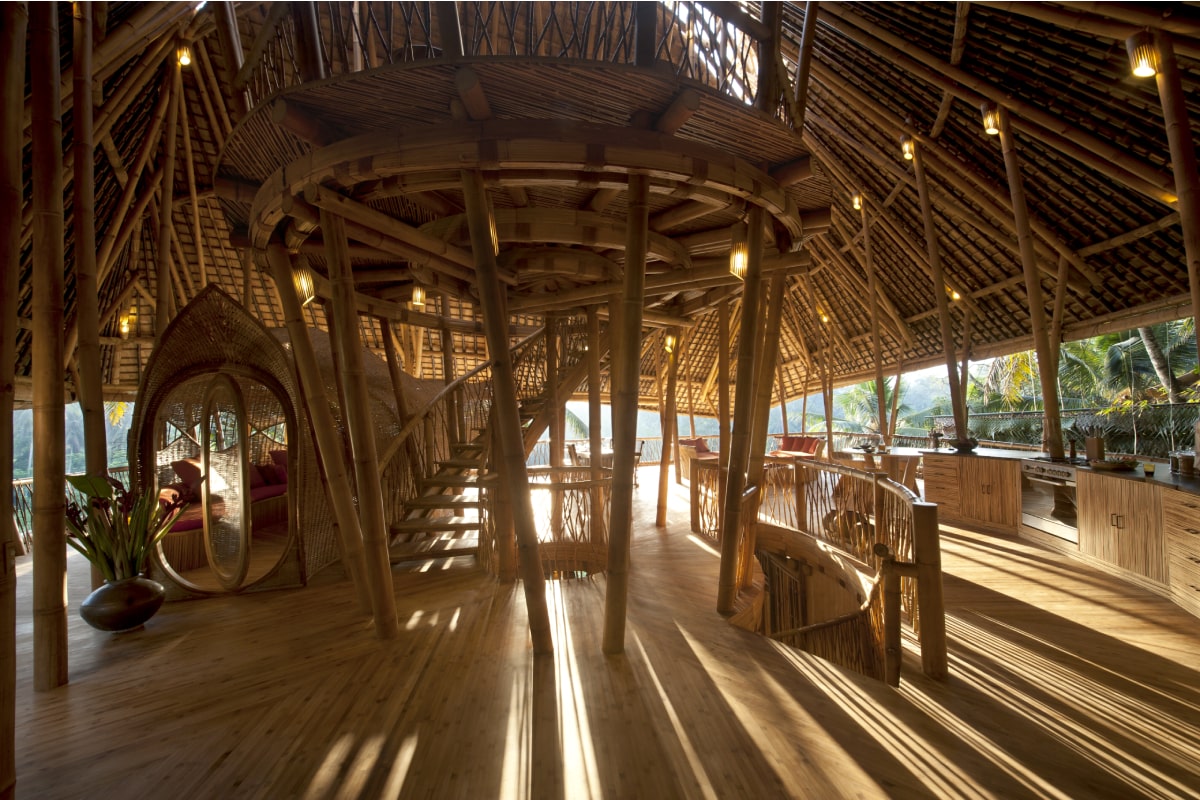
Sunrise House at Green Village (IBUKU). Image © Rio Helmi
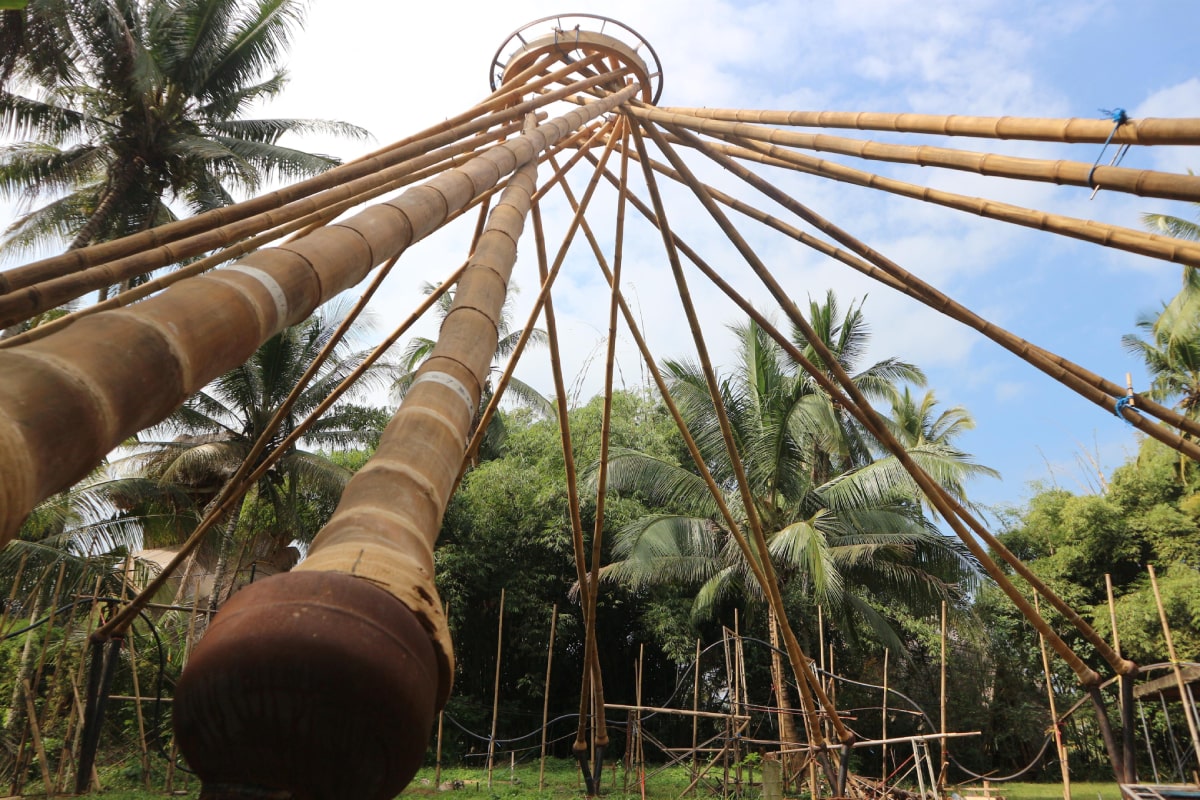
AREA 15 (IBUKU). Image © IBUKU

Mari Beach Club (IBUKU). Image © Mari Beach Club Bali
Megha Balooni: Using natural and sustainable materials is one of the strongholds of your organisation. Could you share some challenges that come with material selection and how you have navigated through them over the years?
Elora Hardy: The challenges of natural materials are many, but so are the opportunities. The beautifully unique tapering hollow form of the raw bamboo poles is a challenge to work with and requires skilled craftsman’s attention, but when we split the bamboo and then bundle or laminate it, we can explore flexible systems that are scalable.
With bamboo, we have gone far beyond the age-old traditional techniques and created a myriad of new construction systems and stylistic directions. An extraordinary resource we have in Bali is that the craftspeople have a familiarity and facility with bamboo because this material has been widely utilised while also dramatically underappreciated across Asia for millennia. Until reliable natural treatment methods became known in the 90s, Bamboo was vulnerable to insect attack and couldn’t be counted on for long-lasting structures. Our legacy at IBUKU is built on Linda Garland’s work with bamboo treatment in Bali, which continues with her son Arief Rabik’s Environmental Bamboo Foundation and Bamboo Villages Initiative, centred on women and agroforestry across the archipelago.
Now, when properly treated with a natural boron solution, bamboo structures can last many decades or even lifetimes. But they need to be built in a way that’s suitable and designed in a way that’s aligned with their strengths. At first, the originality of our design work with bamboo wasn’t so much an artistic direction as it was an effort to listen to the material and then design for its needs. And we increasingly add an element of play, to stretch its possibilities, and incorporate science, to develop its range with technology.
Rita Santoso (IBUKU architect): As with other natural materials, sometimes it's difficult to have bamboo as a building material with measured consistency (the moisture content, the colour tone, etc.). But in the other part of the world where they have more advanced technology involved in processed bamboo materials, bamboo building materials can be accepted in a wider range of projects, not just for residential but for commercial projects (ex. Madrid Barajas Airport with the bamboo ceiling). Introducing those possibilities by designing with bamboo in a project that many can get access to (not restricted to just residential or clubhouses), is our next goal.
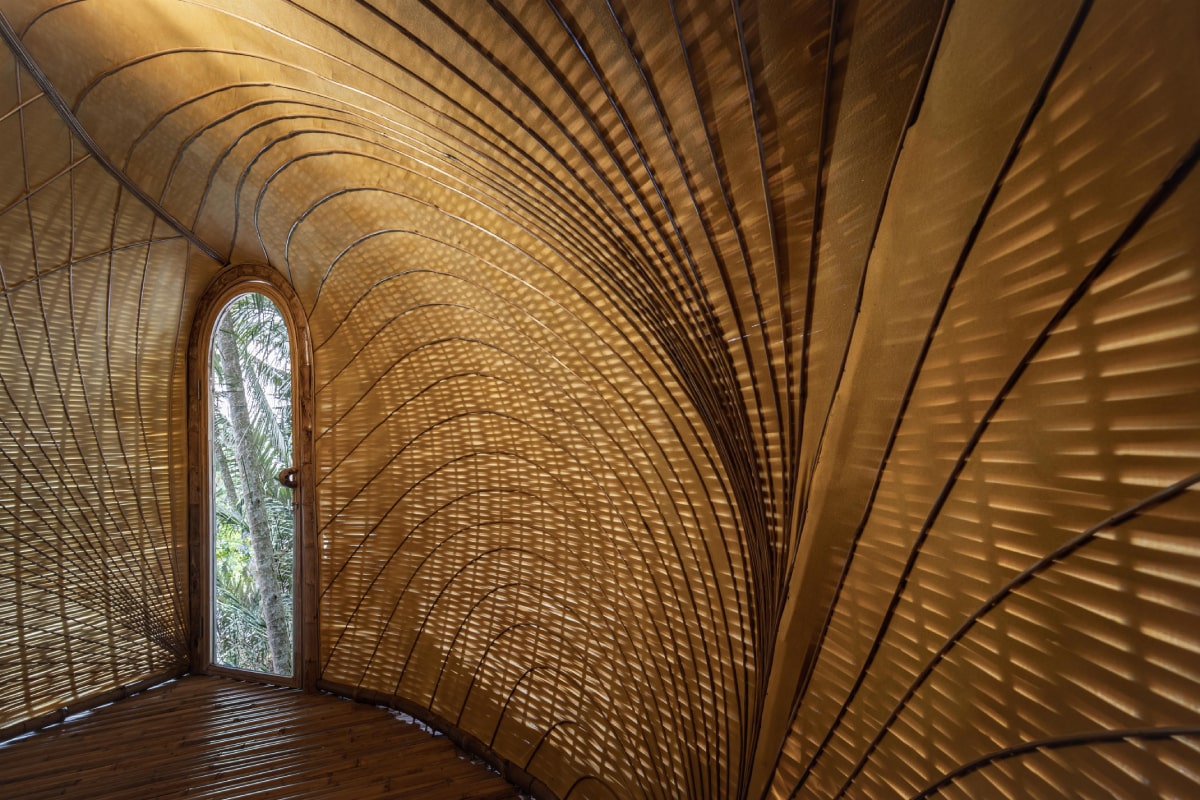
Echo House (Main House; IBUKU). Image © Indra Wiras
The Arc at Green School (IBUKU). Image © Tommaso Riva
Megha Balooni: Speaking about your globally successful project the Ananda House, you shared, "It’s really important to me that we move beyond the bamboo-hut idea." What two applications of bamboo in your projects have been surprising elements/ design aspects for you?
Elora Hardy: Bamboo in its natural form has a tapering cylindrical shape, and each pole is unique, making it complex and challenging to integrate into a design world more familiar with materials that are cut or moulded into prescribed dimensions. When we work with it in laminate or strand woven form, it translates more readily, and we unleash the flexibility of bamboo while letting go of some of its personality. Where we see exciting developments is when we carefully balance our hand-crafted, nature-centric materials and processes with new innovations and systems.
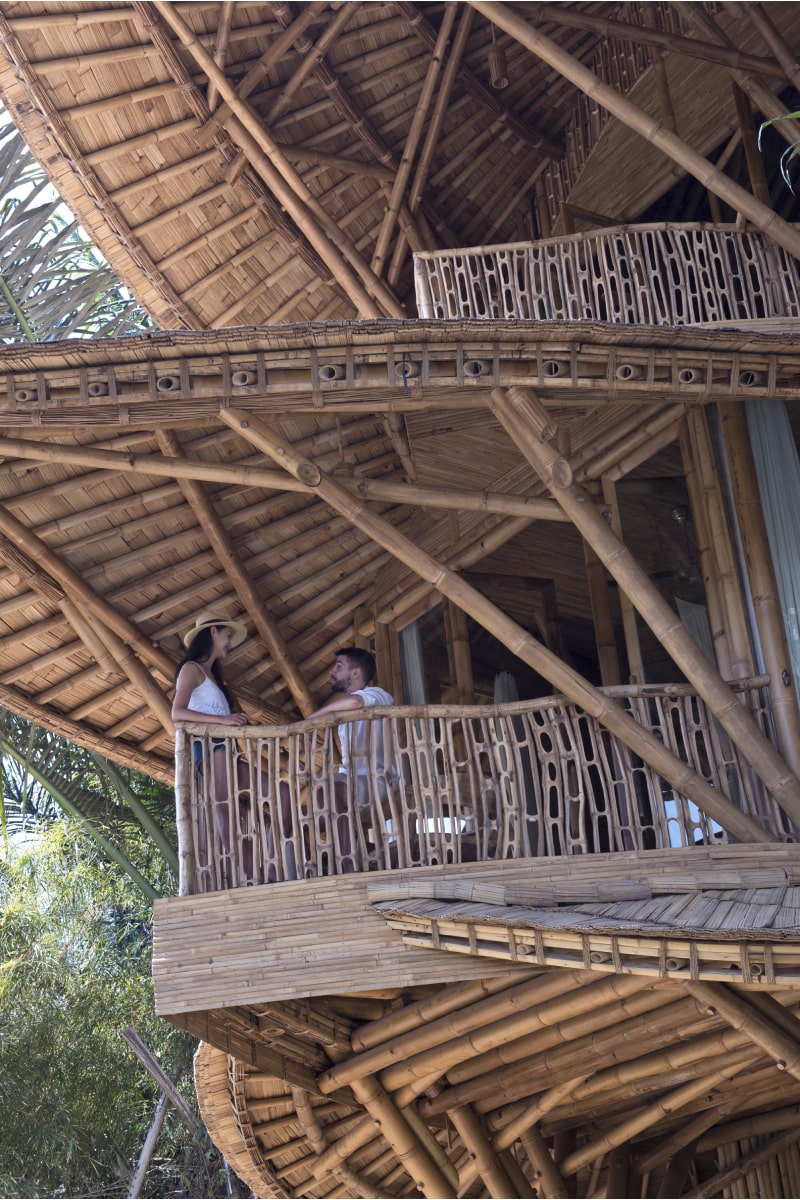
Ananda House (IBUKU). Image © Rio Helmi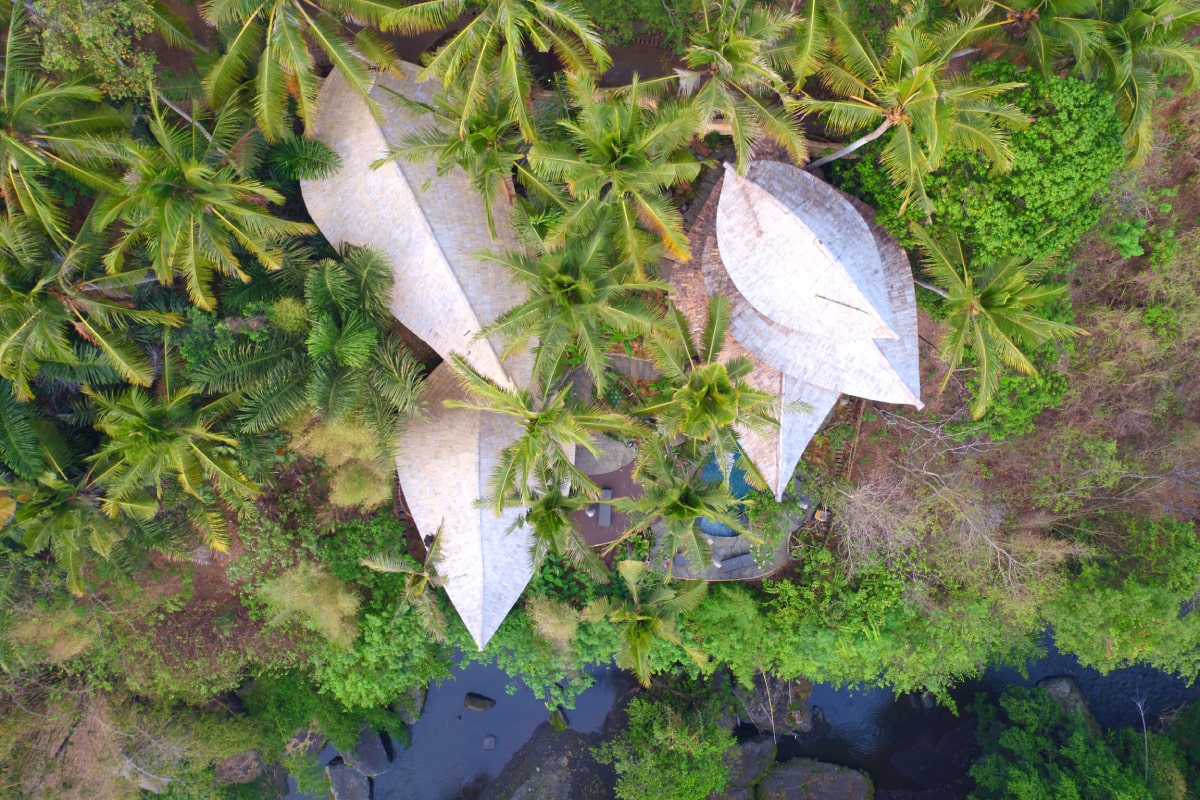
Ananda House (IBUKU). Image © Shaan Hurley
Megha Balooni: How much, would you say, IBUKU's current design ideologies are inspired by the John Hardy Jewellery Factory?
Elora Hardy: One of the earliest curving bamboo structures in Bali is Kapal Bambu at the John Hardy workshop. My father John collaborated with architect Yew Kuan Cheong to design it onsite without drawings, arranging tall tapering poles. John and his wife Cynthia went on to build the entire Green School campus out of bamboo along with Jorg Stamm and Aldo Landwhr, and I worked with the team to realize Green Village and many more projects over the subsequent 12 years. While we still utilize some of the original techniques, we have evolved. The focus of our design process isn’t the material, as might be assumed, it’s the people who will spend time in the place. We begin by focusing on how people want to feel, and what they want to do, and then how to wrap the form of the structure around them. Wherever we are in the world, we consider all the materials and skills we can find and depending, the place might lead us into a collaboration with bamboo, sometimes not. The common thread is beauty. We want to capture people’s hearts, and through that connection make something new possible.
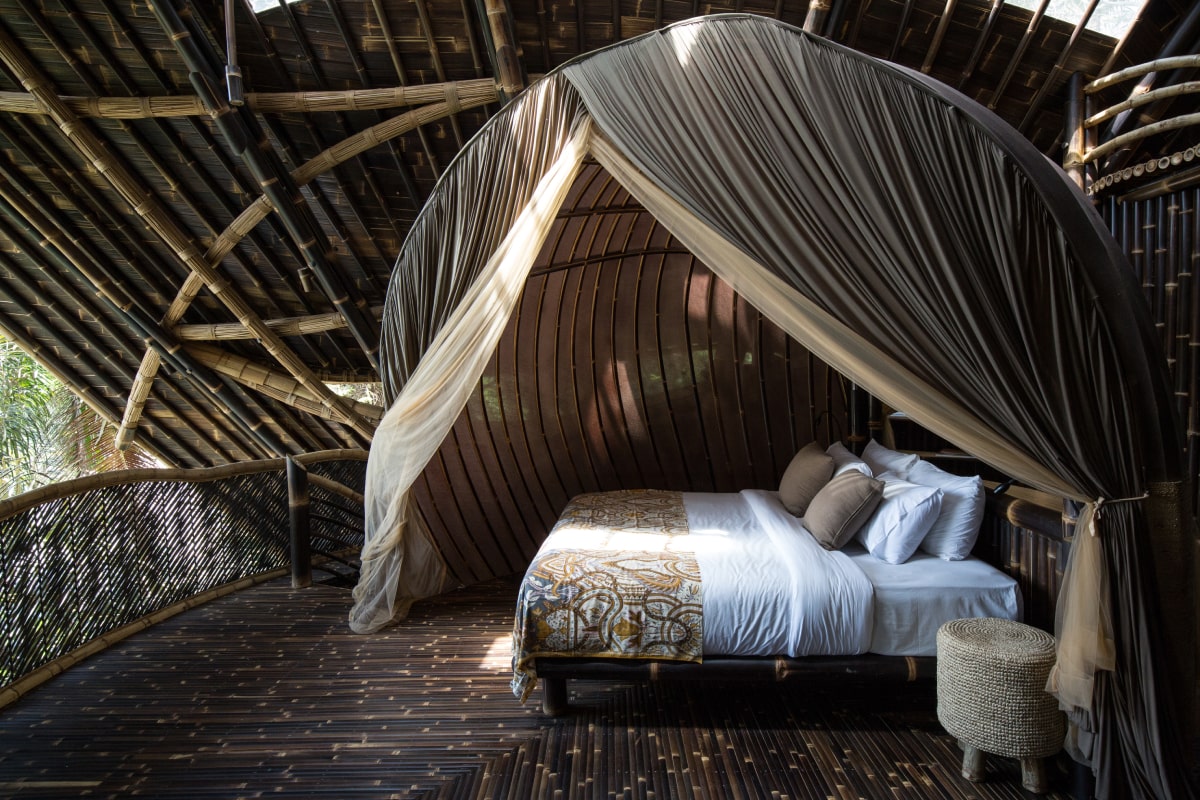
Eclipse Main and Guest House (IBUKU). Image © Tommaso Riva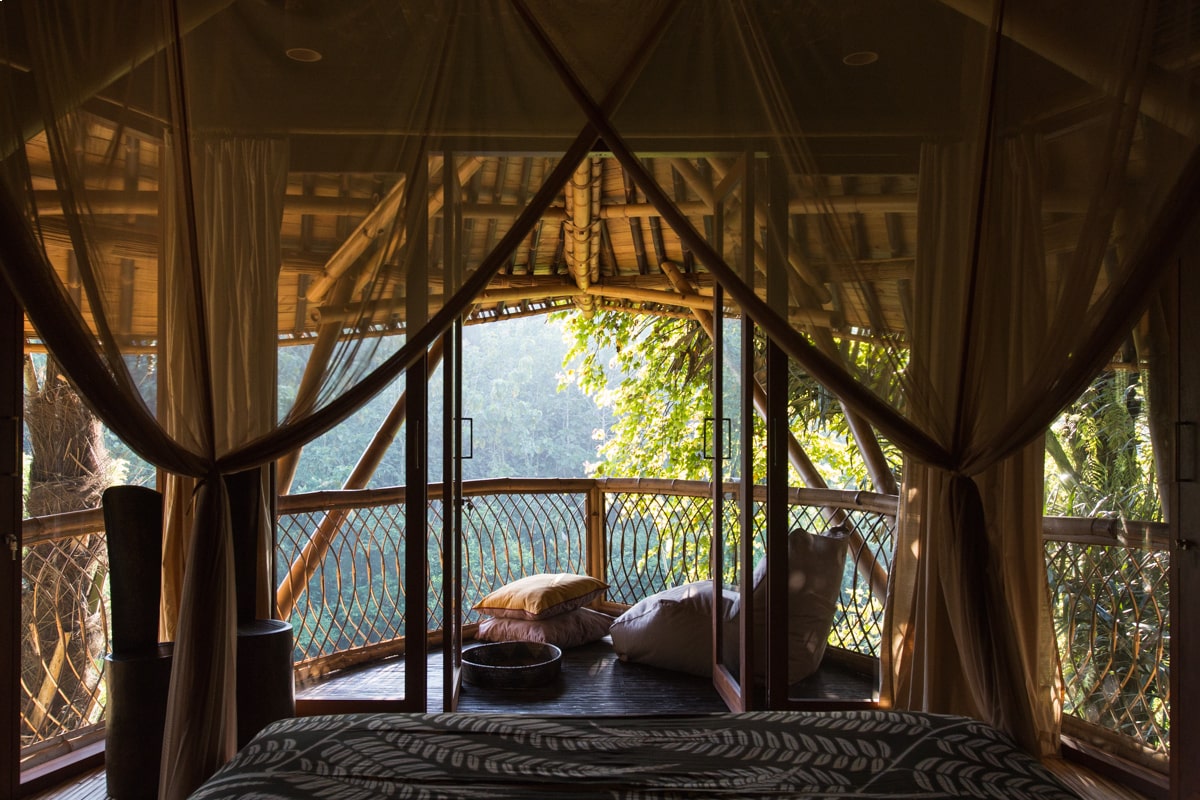
Eclipse Main and Guest House (IBUKU). Image © Tommaso Riva
Megha Balooni: The Arc at Green School is, probably, one of the most path-breaking projects in recent times. What was one of the most gratifying memories during the project's design and construction?
Elora Hardy: The Arc is the complex product of the blend of creativity and technique that we strive for. The Arc’s shape is carefully and precisely calculated and constructed with extreme precision. It consists of a series of intersecting arches, bound together by a series of anticlastic gridshells. As far as we know, this combination has never been done before in any material. The gridshells curve in two opposite directions which allows the structural mesh to achieve incredible spans through shape stiffness. The fact that the structure spans 19 meters and reaches 14 meters tall is stunning, especially considering that the structure does not rely on trusses to achieve that span. By making the geometry do much of the work, the structure feels almost impossibly light. It is uncomfortable as a designer to leave the form in the hands of engineering tests, but that collaboration was ultimately exciting and gratifying.
Jules de Laage (Construction Manager and Site Architect, IBUKU): There is something extraordinary about ancestral craftsmanship meeting modern construction techniques. To ensure the precision required to build such a structure, the craftsmen worked within a three-dimensional coordinate system that allowed the curvatures of the gridshells to adhere entirely to the specific engineering requirements.
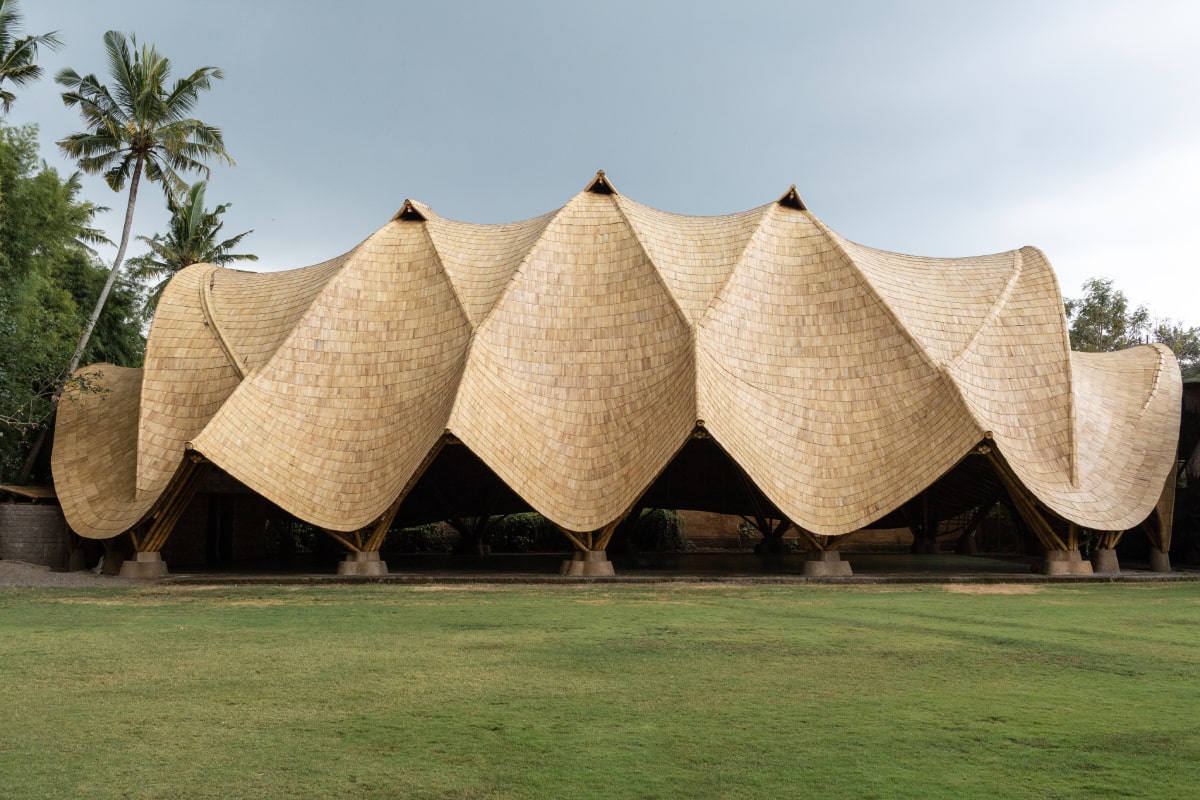
The Arc at Green School (IBUKU). Image © Tommaso Riva

The Arc at Green School (IBUKU). Image © Tommaso Riva
Megha Balooni: Your projects are not only sustainable but the attention to detail paid to materials exhibits unique properties of vernacular materials. Could you suggest how one can sensitise this practice more?
Elora Hardy: Innovative thinking is what designers need. I see tangible examples of this, especially through Bamboo U, the course my brother Orin Hardy and his wife Maria founded. Initially, the goal was to share bamboo knowledge. What I see happening is that people learn to think like bamboo. Understanding the variabilities of natural materials bends our brains, and pulls us out of the linear sequence of assumptions that so much of the world today is built from. We need new ways of thinking, for a chance at a healthy world.
At IBUKU we’ve revealed bamboo’s inherent beauty, aligned with this specific place and these craftsmen and for the needs and wishes of each of our clients, while also aspiring to transcend the material itself. Occasionally someone will say to me, “I didn’t think I liked bamboo, but I love this building!” Hence, we’ve moved people with a new sense of place and space in a way that goes beyond materiality, with people now often asking us to design for them regardless of whether it’s possible to build with bamboo in the climate or building code where they are. We are expanding our imagination, collaborating with designers, engineers, and builders around the world, and always asking ourselves what belongs where each building will be. We are lighting the way, demonstrating that a beautiful green future is possible. If we can build castles out of the grass, what else is possible?

Echo House (IBUKU). Image © Tommaso Riva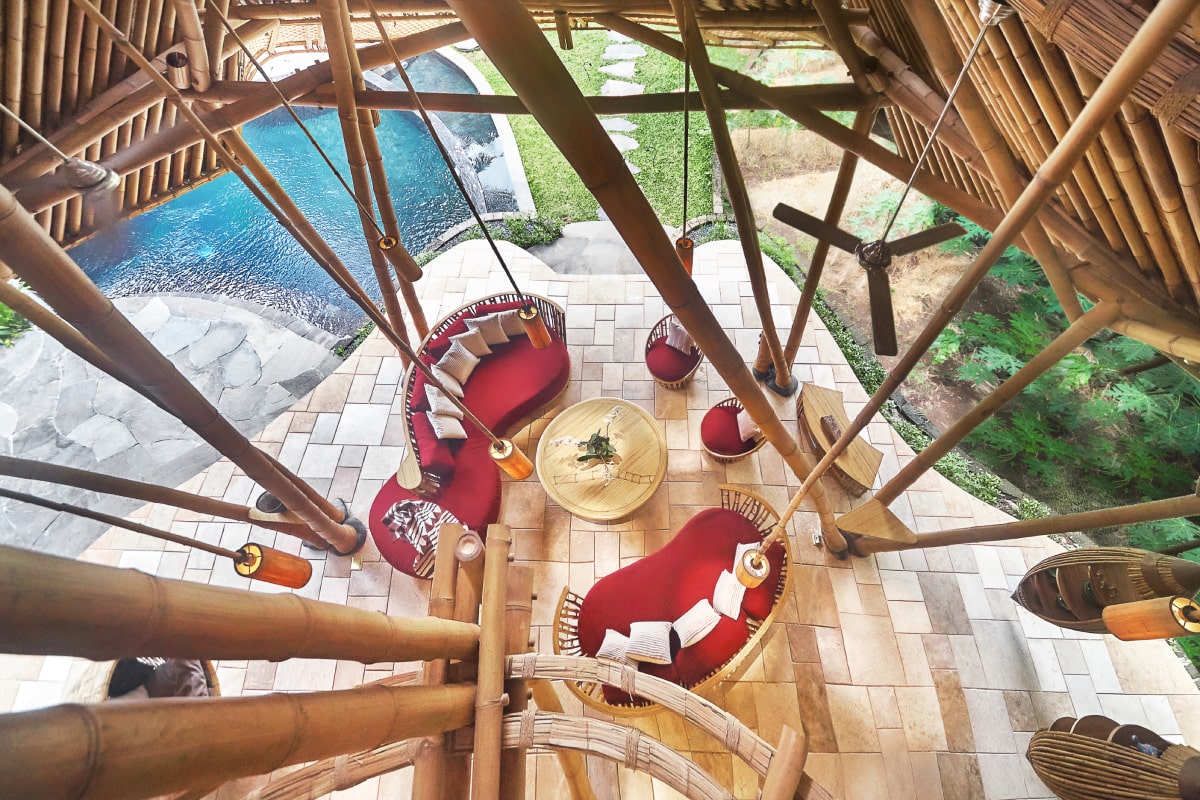
Cacao House (IBUKU). Image © Alina Vlasova
Megha Balooni: “From a crafts person's perspective, there is a constant improvisation... find a flow with them, and plan them into the overall dance of the item.” (Talking about Bamboo Pure’s Process). Could you share a few ways which can motivate younger architects/designers to find flow and plan their designs with a dance quality?
Elora Hardy: As designers we are creating the world, creating the future, and we have a say. Designers have a responsibility to seek out and elevate, or when necessary to fight for, materials that they can be proud to work with, and are excited to learn from and be challenged by. We each have a conscience, and we would aspire to be well remembered and admired when people in the future look back at our work and impact. In the future people will look back and wonder “What were people thinking? They saw the problems coming, why didn’t they change faster?” While ultimately most designs are impacted by whoever is financing the work, designers have a responsibility to be innovative and push for the best results, even to think bigger than the immediate project brief.
Rita Santoso (IBUKU architect): It’s the architect’s role to explore what a material can be used for, to design new ways to use it, remember its value. While doing so, we gained new knowledge that can be passed on to younger generations.

The Arc at Green School (IBUKU). Image © Tommaso Riva
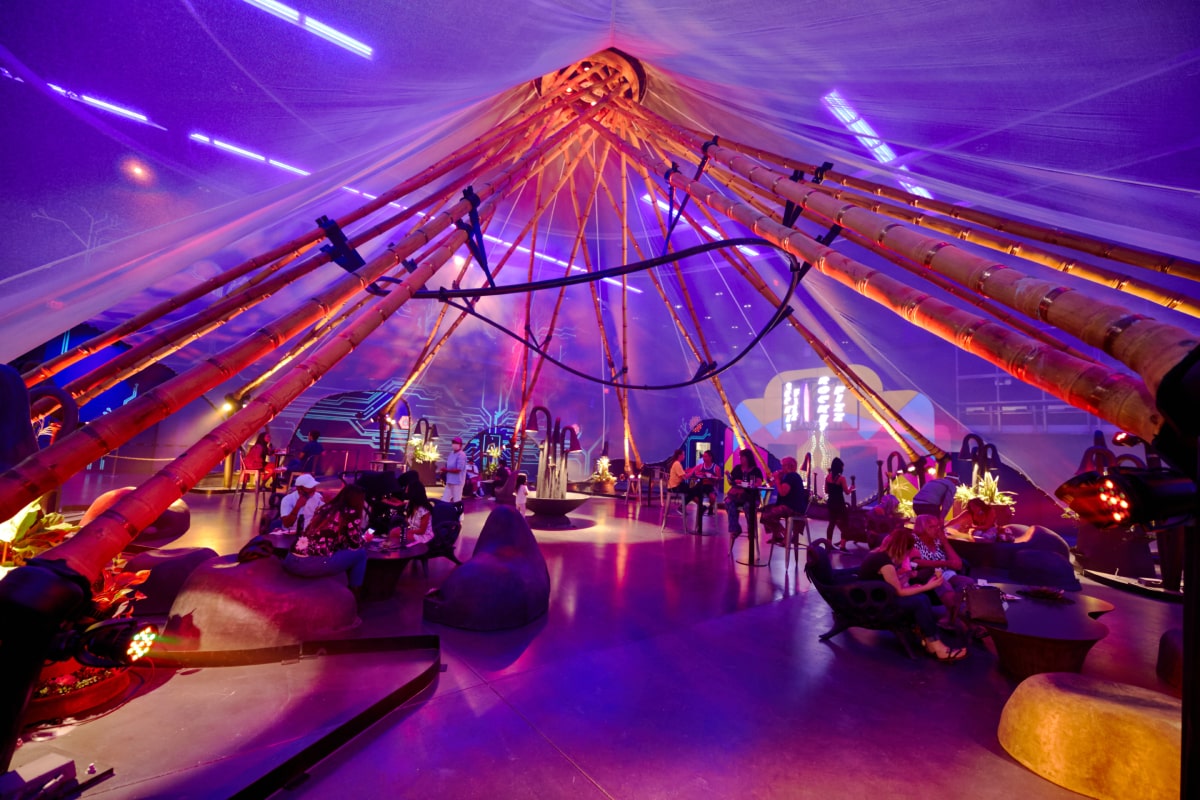
AREA15 (IBUKU). Image © Laurent Velazquez
Megha Balooni: Lastly, could you share a project of your studio where you feel the material used outdid the vision you had for the design?
Elora Hardy: I don’t see how to make a distinction between the material and the vision. I can’t imagine the material shining and outdoing a design idea, because the design idea should be interwoven with the choice of material. Our earliest projects each have aspects that capture something true about bamboo that makes us feel good in the space, and each also has areas where our use of the material is clumsy. Materiality and vision work in parallel.
Rita Santoso (IBUKU architect): There's so much to learn simultaneously that it shifted my architect's design objective. Each building built contains the owner's life journey and our design journey to translate that story. And from each building built we're taught how to understand bamboo better and what future bamboo can bring.
For example, in Aura House, the design outcome taught us that bamboo, even in its natural colour can be so rich in textures. We played with different types of processed bamboo, from (mainly) 3 types of bamboo species, all in one tone (golden bamboo) for that house.
Because we're designing with bamboo and want to connect with nature, we become more sensitive to "nature's call". For example, when designing the Echo Guest House, the existing vegetation and contour kind of tell you what texture and tone of bamboo would be suitable to use there. Another example is our overseas projects, even if we're not on the site, we get the picture of what kind of experience we want to bring to our design. It's just when you work with bamboo that blends so well with nature, you'll see your design canvas (the site) in a specific way where you want to connect to nature by being in it without changing it much, and I think I'm keen on doing so for the rest of my design adventure.
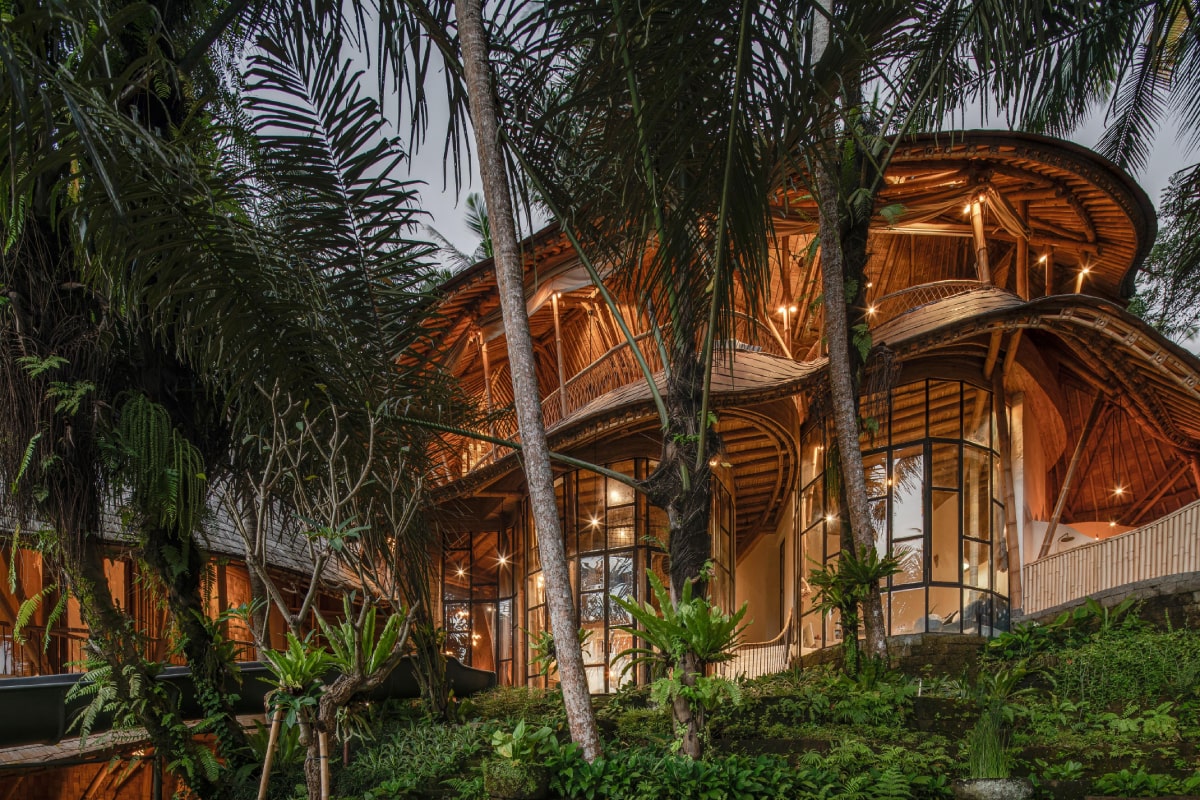
Echo House (Main House; IBUKU). Image © Indra Wiras
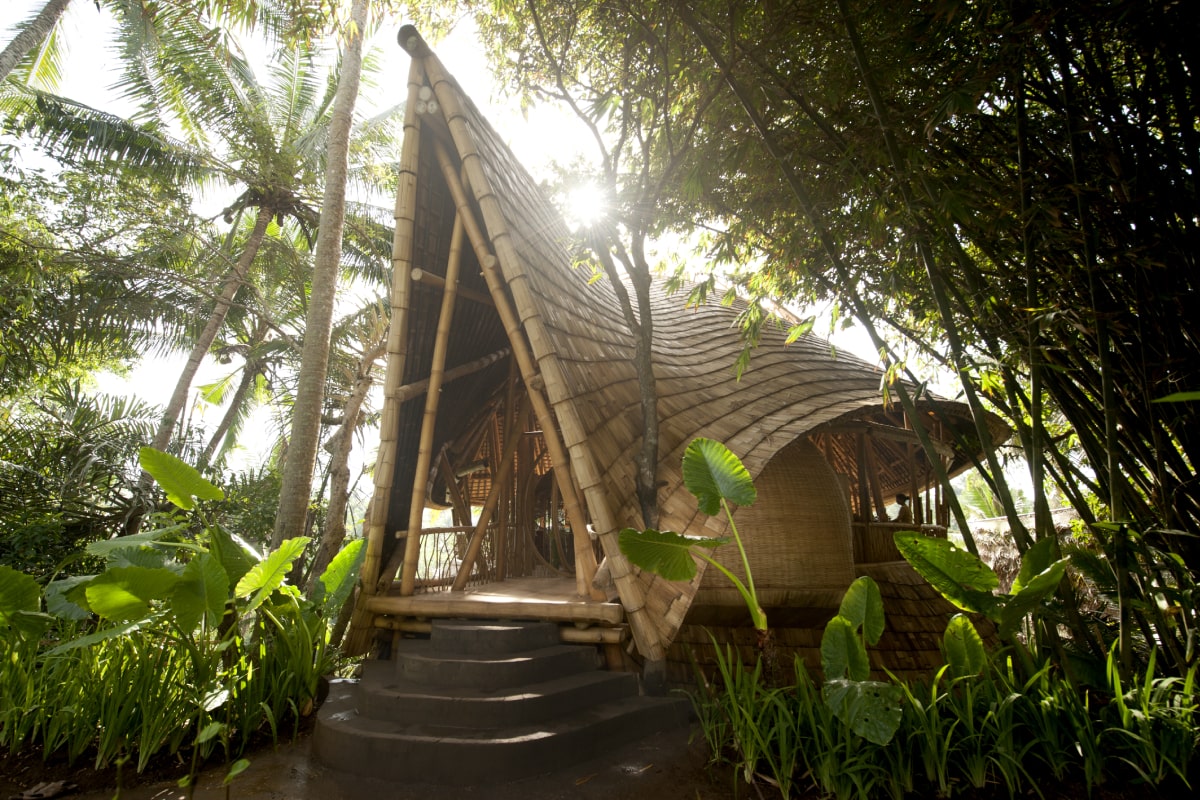
Sunrise House at Green Village (IBUKU). Image © Rio Helmi
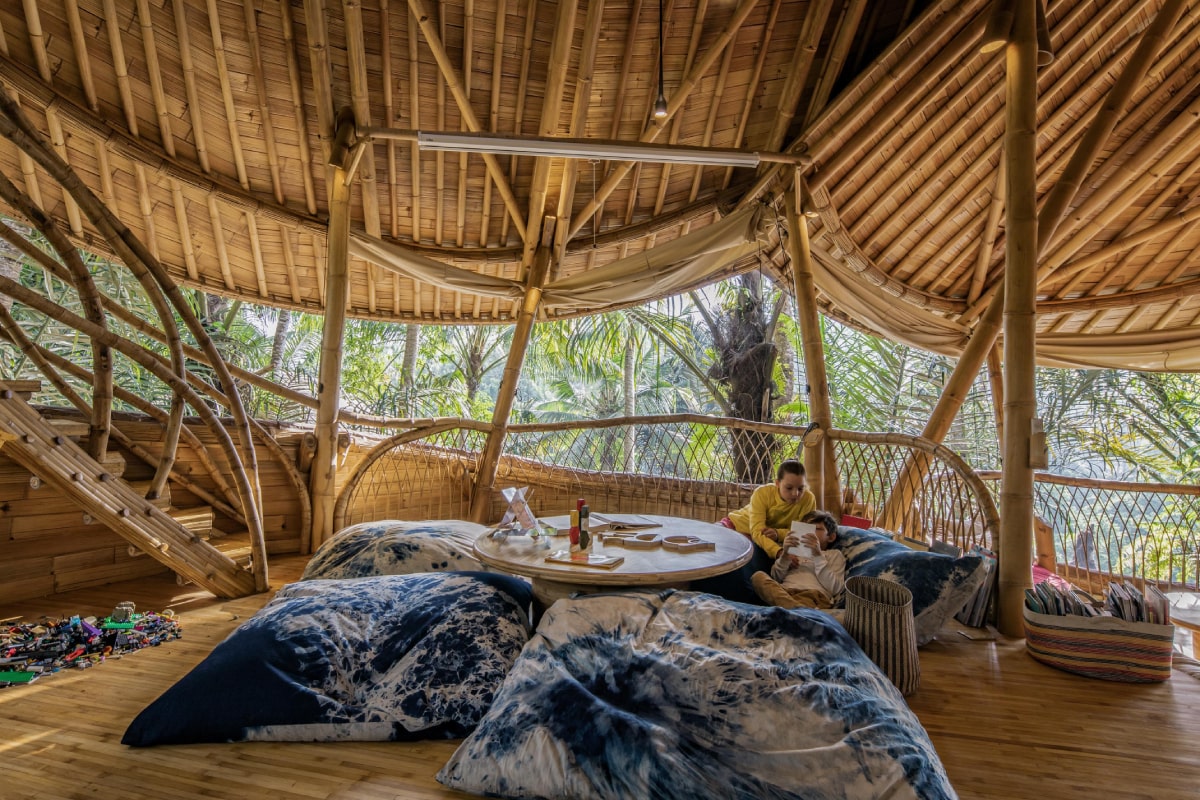
Echo House (Main House; IBUKU). Image © Indra Wiras
About IBUKU
In 2010 Elora Hardy, returned to Bali to continue the evolution of bamboo design under the name IBUKU and established the workshop and construction company known as PT Bamboo Pure. Over the next decade, Elora led the teams to complete over 100 distinct structures in Bali and beyond. IBUKU is a team of designers and architects that is exploring innovative ways of designing with natural materials to build homes, hotels, schools, and event spaces around the world.
Head Image: Cacao House (IBUKU). Image © Alina Vlasova.
